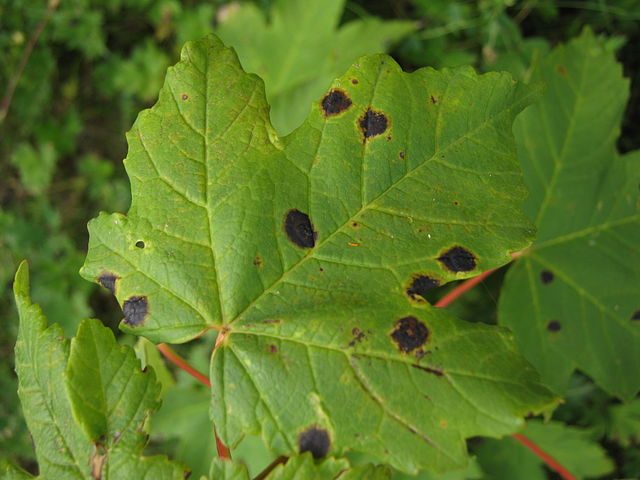This is the seventh part of a series on spring tree diseases. This article examines maple tar spot, and Rhizosphaera needle cast.
Introduction
In spring, as the growing season commences, trees become vulnerable to infection from a bevy of diseases. While some of these diseases are relatively benign, many of them can cripple their hosts. The following describes some of the most common diseases to afflict plants in spring, and how they impact their hosts.
Maple Tar Spot (Rhytisma)
Maple tar spot is a fungal disease that affects many species of maple. The disease occurs most frequently in North America and Europe. It is caused by three related fungi: Rhytisma acerinum, Rhytisma americanum, and Rhytisma punctatum. Symptoms vary between the three pathogens, but they all produce fungal spots on host plants that resemble tar. While maple tar spot occurs on many species of maple, it is most common on Norway, red, and silver maple.
Hosts
Maple tar spot afflicts many species of maple, including big leaf, mountain, Norway, red, rocky mountain, silver, sugar, and sycamore maple. It may also occur on boxelder, willow, and tulip-tree.
Symptoms of Infection
Initial symptoms develop on infected leaves in early summer. At this stage, the leaf spots are light green to yellow green. As the growing season progresses, the spots enlarge, and the yellow coloring intensifies. On red and silver maple, a black lesion usually develops in the center of each yellow spot. These black lesions appear from mid-July to early August. The black lesion grows in diameter and thickness until late summer, when it resembles a spot of tar. The surface of the lesion may feature a pattern of wavy indentations, or ripples. Late in the growing season, infected leaves may drop early. Not all infected leaves are shed. Defoliations are often minor.
Symptoms differ on striped and Norway maple. On these trees, twenty to fifty small spots appear on infected leaves in late July or early August. On striped maple, the spots enlarge slightly. This type of tar spot is often referred to as speckled tar spot. On Norway maple, the spots grow significantly. They eventually coalesce, yielding a black mass that can measure up to 1 ½ inches in diameter. On Norway maple, the surface of the black mass may be slightly roughened or smooth.
Treatment
- Maple tar spot does not cause significant damage to trees. The most effective management practice is raking and destroying infected leaves in fall. This will reduce the number of spores available the following spring.
- Mulching infected leaves will destroy many of the spots before they mature. As a precaution, the mulch pile should be covered, or shifted before new leaves emerge in spring.
- Fungicides are available for controlling maple tar spot. Applications should be performed in spring. To ensure success, complete coverage of the leaf tissue is required.
Rhizosphaera Needle Cast (Rhizosphaera kalkhoffi)
Rhizosphaera needle cast is a fungal disease that affects many spruce trees, particularly Colorado blue spruce, and Engelmann spruce. The causal agent of the disease is the pathogen, Rhizosphaera kalkhoffi. Rhizosphaera needle cast was first observed in 1939. It was reported infecting Colorado blue spruce in Connecticut. Rhizosphaera needle cast is now regarded as one of the most common needle diseases to affect spruce trees.
Hosts
Colorado blue spruce, and Engelmann spruce are highly susceptible to infection. Infections also occur on white spruce and Douglas-fir, albeit with less frequency. Norway spruce exhibits relative resistance to the disease. As such, it is rarely infected. Trees that are undergoing environmental stress, or are infested with insects are more prone to infection. Young trees, and saplings are most vulnerable to infection, though trees of all ages may be invaded by the pathogen.
Symptoms of Infection
Infected spruce trees will only retain a single year of growth. Foliage on the inner branches, and on the lower portion of the crown is most susceptible to infection. When infections are severe, the lower branches will die back, and the disease will progress to the upper branches. In summer, the infected needles turn yellow. By fall, they deepen to reddish brown or purple. Trees that are sparse on the lower part of the crown, or only display a year or two of needle growth may be infected. The needles of symptomatic trees should be examined in early spring, prior to bud break. Black fruiting bodies may be observed in neat lines, along the length of the infected needles. Branches that are defoliated for three to four years will die back. This can cause the tree to develop a malformed appearance, reducing its ornamental value.
Treatment
- Plant spruce trees in locations that feature good drainage.
- When planting, select resistant varieties of spruce. Norway spruce, Black Hills spruce, and white spruce all exhibit an increased resistance to the disease pathogen. Trees that are grown from healthy nursing stock are ideal for planting. Avoid planting young spruce trees near older spruce trees that may be harboring the disease pathogen. Ensure that plants are afforded sufficient space to allow for proper air circulation.
- To limit the number of potential inoculum sites, eliminate weeds by periodically mowing the grass.
- Rake, and dispose of fallen needles to further reduce potential inoculum sites.
- Fungicide applications are effective at combating the disease. Initial applications should be performed when new shoots are ¾ of an inch to 1 ¼ inches long. Moderate to severe infections may require two additional applications at three week intervals.
- Maintain tree vigor through sound cultural practices. Ensure that trees are sufficiently watered, especially during extended periods of drought. Apply a layer of organic mulch around the base to improve soil quality, moderate soil temperature, and maintain soil moisture.
Photo courtesy of Richard Avery CC-by-1.0


